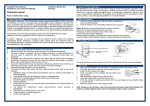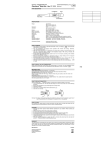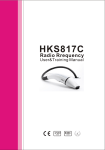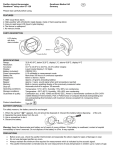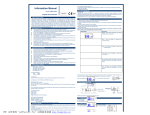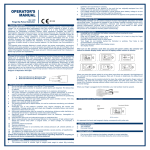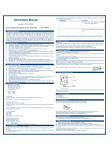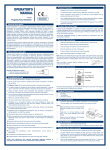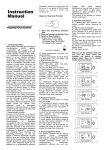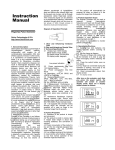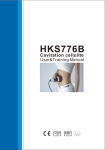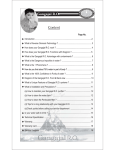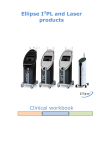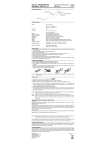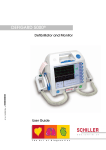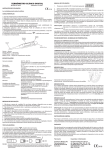Download BA oxy control 4c 09-10-22_D.indd, page 8 @ Preflight
Transcript
Fingertip Pulse Oximeter GB Instruction manual GT-300C320 0118 TABLE OF CONTENTS General Description Precautions Range of Application Battery Installation Description of Front Panel Instructions for Use Evaluation of Pulse Oximetry Specification Possible Problems and Solutions Cleaning Instructions Limited Warranty 14 15 16 16 17 17 20 21 22 24 24 GENERAL DESCRIPTION GB Haemoglobin saturation is the percentage of oxygen-bearing haemoglobin (HbO2) molecules in proportion to the amount of oxygen that the haemoglobin (Hb) is capable of carrying in the blood. It expresses the concentration of oxyhaemoglobin in the blood and is a very important parameter of the respiratory and circulation system. Many respiratory diseases can result in a decline in haemoglobin saturation levels. In clinical medicine it is very important to determine a patient’s haemoglobin saturation level in good time so as to detect problems sufficiently early. Pulsoximetry is a non-invasive monitoring procedure for the determination of oxygen saturation in arterial (oxygenated) blood by means of a photosensor. To obtain a diagnosis, it is only necessary for the patient to lay one of his fingers on a photoelectric sensor. The display screen shows the measured value of haemoglobin saturation. Clinical experiments have demonstrated the high degree of precision and repeatability of this procedure. 14 PRECAUTIONS 1 Do not use the pulse oximeter in an MRI or CT environment. 2 Explosion hazard: Do not use the pulse oximeter in an explosive atmosphere. 3 The pulse oximeter is intended only as an ancillary procedure in patient assessment. It must be used in conjunction with other methods of assessing clinical signs and symptoms. 4 Prolonged use or the patient’s condition may require that the sensor site be changed regularly. Change the sensor site and check the patient’s skin integrity, circulatory status, and correct alignment at least every 4 hours. 5 Inaccurate measurements may be caused by autoclaving, ethylene oxide sterilizing, or immersing the sensors in liquid, which will result in inaccurate readings. 6 Store the pulse oximeter in a dry environment. 7 The following factors may impair the SpO2 measurements and/or lead to inaccurate readings: • Significant levels of dysfunctional haemoglobins (such as carboxy-haemoglobin or methaemoglobin) • Intravascular dyes such as indocyanine green or methylene blue • High levels of ambient light (shield the sensor area against direct sunlight) • Excessive patient movement • Venous pulsations • Placement of a sensor on an extremity with a blood pressure cuff, arterial catheter, or intravascular line • The patient has hypotension, severe vasoconstriction, severe anaemia, or hypothermia • The patient is in cardiac arrest or is in shock • Fingernail polish or artificial fingernails • Cold or dirty fingers 15 GB RANGE OF APPLICATION The Geratherm® oxy control 4c can be used to measure human haemoglobin saturation levels and the heart rate via a finger. The product is suitable for use at home, in hospital (including clinical use in internal medicine/surgical wards, in anaesthesia, paediatrics, intensive care units etc.), in social medical institutions or in sports medicine (it can be used before and after sporting activity - use during sporting activities is not recommended). BATTERY INSTALLATION GB 1. Place the two AAA batteries inside the battery compartment ensuring correct polarity. 2. Slide the battery cover on horizontally as shown by the arrow. Notes: Batteries must be inserted with the correct polarities. Otherwise, damage might be caused to the device. Please insert or remove batteries in the correct order, or the device bracket may be damaged. Please remove the batteries if the oximeter will not be used for a long period. When the battery status indicator appears, replace the batteries in good time. 16 DESCRIPTION OF FRONT PANEL Perfusion Index (PI) Pulse Pulse rate frequency indicator SpO2 / oxygen saturation Battery status indicator 97 74 Graphic representation of SpO2 The pulse frequency indicator flashes on and off in accordance with the pulse rate displayed. INSTRUCTIONS FOR USE 1 Insert two AAA batteries into the battery compartment before replacing the cover. 2 Press the device at the rear end so as to open the front section for the insertion of a finger. 3 When your finger is in the oximeter, the nail surface must face upwards. 4 After inserting the finger let go of the rear end. 5 Press the power button on the front panel once. 6 While the oximeter is working, you should not move your finger and you should keep still and quiet. 7 Read the values shown on the display screen. 17 GB INSTRUCTIONS FOR USE After turning on the oximeter, each time you press the power button the oximeter will switch to another display mode. There are 6 display modes, as follows: 1. 2. 97 97 74 3. 74 4. 97 97 74 74 GB 97 74 74 6. 97 5. Press the power button for a fairly long time (longer than 1 second) in order to set the brightness level of the display panel. Holding the button down will cause the brightness of the oximeter to change gradually. There are 10 brightness levels. The default level is level four. 18 INSTRUCTIONS FOR USE Audible pulse rate indicator During the measuring procedure you will hear a tone indicating your pulse rate. Alarm: Range: SpO2: Pulse rate: <90% <60 bpm or >100 bpm Alarm modes: audible and visual alarm • Visual alarm: The measured pulse and oxygen values flash if they exceed the previously set lower or upper limits. • Audible alarm: This can be switched on or off. The alarm sounds briefly twice if the measured values exceed the previously set limits. • Switching the alarm on and off: In order to switch the alarm off, press the on/off button when the audible alarm sounds. You will enter alarm mode for a period of 30 seconds, thus switching the alarm off. However, you only switch off the alarm tone, not the audible pulse rate indicator. The alarm mode is automatically switched off if a new alarm sounds or the measured values are within the normal range. Perfusion Index (PI) The perfusion index (PI) shows the signal strength of the arterial pulse and indicates the proportion of pulsatile signals to non-pulsatile signals. The bar is highest when the quality of the blood supply is at its best. PI is influenced by the strength of the pulse rate, the quality of the blood supply to the fingertip and the temperature of the finger. If, for example, the pulse rate is weak, the blood supply to the fingertip poor or the finger temperature low, the PI will also be low. 19 GB EVALUATION OF PULSE OXIMETRY In healthy patients, oxygen saturation levels lie between 96 and 98 %. Values below 95 % can indicate a health disorder and make it necessary to supply the patient with additional oxygen. If your oxygen saturation value is below 95 %, please consult your physician. Normal pulse values depend on the age and fitness level of the individual. Here are a few reference values indicating normal pulse rates: • • • • Infants under 1 year: 100 - 160 bpm Children between 1 and 10 years: 70 - 120 bpm People over 10 years: 60 - 100 bpm Highly trained individuals/athletes: 40 - 60 bpm GB 20 SPECIFICATION 1. Display type: 4-colour LCD-display 2. SpO2: Measurement range: 70 – 99 % Accuracy: ±2 % between 80% and 99%; ±3% between 70% and 80% 3. Pulse rate: Measurement range: 30 - 235 bpm Accuracy: ±2 bpm or ±2 % Pulse intensity: Pulse rate indicator 4. Power requirements: Two alkaline batteries, type AAA 1.5 V, 600mAh Power consumption: Less than 40mA Battery status indicator: Battery life: up to 30 hours in continual use 5. Dimensions: Length: 60mm; Width: 34mm; Height: 30mm Weight: 50g (including two AAA batteries) 6. Environmental requirements: Operating temperature: 5 - 40 °C Storage temperature: -10 - 40 °C Humidity: 15 % - 80 % in operation 10 % - 80 % in storage 7. Quality standards: Certification in compliance with EN ISO 13485, Conformity in compliance with EN 9919:2005 Medical electrical equipment - Particular requirements for the basic safety and essential performance of pulse oximeter equipment for medical use, EN60601-1, EN606011-2, standard Council Directive 93/42/ EEC 21 GB POSSIBLE PROBLEMS AND SOLUTIONS Problems Possible reason Solution SpO2 or PR cannot be shown normally. 1. Finger is not inserted correctly. 2. Patient’s oxyhaemoglobin level is too low to be measured. 1. Try inserting the finger again. SpO2 or PR is shown unstably 1. Finger might not be inserted far enough. 2. Finger is trembling or the patient’s body is moving. 1. Try inserting the finger again. 1. Battery power may be inadequate or not be there at all. 2. Batteries may have been inserted incorrectly. 3. The oximeter might be damaged. 1. Please replace batteries. GB The oximeter cannot be switched on 22 2. Try several more times if you are sure that there is no problem with the device. Please go to a hospital in good time to obtain a precise diagnosis. 2. Try not to move. 2. Please reinsert the batteries. 3. Have the device tested by the manufacturer POSSIBLE PROBLEMS AND SOLUTIONS Problems Possible reason Solution Indication lamps suddenly go off 1. The product is automatically switched off if no signal is detected for longer than 8 seconds. 2. Low power/ Batteries empty 1. Normal 1. Low power/ Batteries empty 2. Receiving sensor shielded or sensor damaged. 1. Insert new batteries. 1. Low power/ Batteries empty 2. Infrared sensor damaged. 1 Change the batteries. “Error3” or “Error4” displayed on screen “Error7” displayed on screen 23 2. Replace the batteries. 2. Have the device tested by the manufacturer. GB 2 Have the device tested by the manufacturer. CLEANING INSTRUCTIONS Please use medical alcohol to clean the synthetic material touching the finger inside the oximeter, and clean the test finger before and after using. Please clean the surface of the pulse oximeter before each use. LIMITED WARRANTY This pulse oximeter is guaranteed for 2 years from the date of purchase against manufacturer’s defect under conditions of normal use. GB Following the instructions precisely will ensure that the device functions reliably for many years. If your pulse oximeter does not function properly due to defective parts or assembly we will repair it free of charge. All parts of the pulse oximeter are covered by this warranty. The warranty does not cover damage to your unit due to improper handling. The manufacturer recommends that the accuracy of the device be checked by an authorized laboratory every 2 years (in Germany this is a statutory requirement). You must adhere to the applicable regulations when disposing of the device. Manufacturer: Geratherm Medical AG Fahrenheitstraße 1 98716 Geschwenda Germany 24












